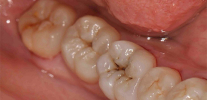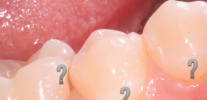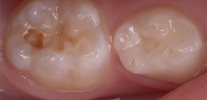
A caries marker is a special substance that, when applied to caries-affected tissues (demineralized enamel, dentin), is fixed on them, and thanks to its bright, noticeable color, it allows the doctor to detect the carious zone or clearly define its boundaries. At the same time, the caries marker does not linger on the healthy tissues of the tooth and is easily washed off when washed with water.
Simply put, caries marker paints denatured areas of tooth damaged by caries in bright contrasting colors and increases the ease of their detection.
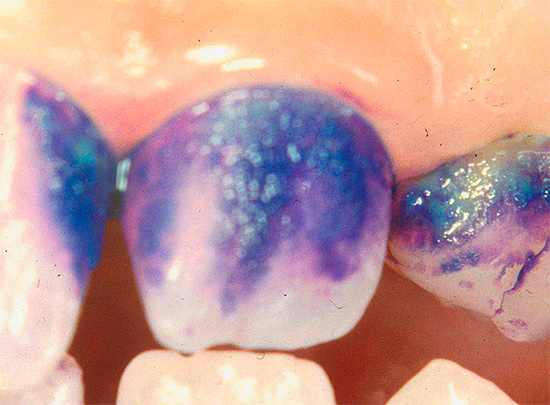
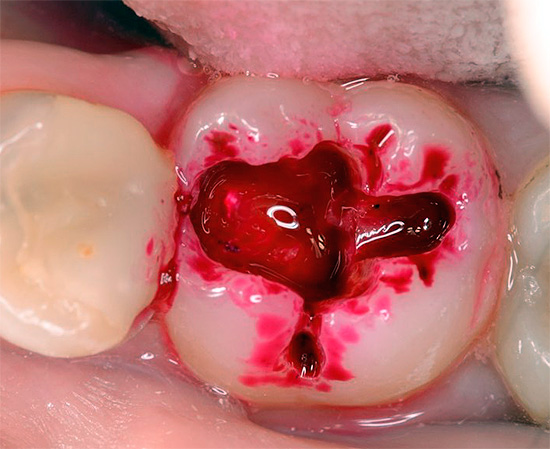
At the same time, the terms "caries detector" and "caries marker" should be distinguished. Caries marker is only one of the types of caries detectors, although some authoritative authors believe that these are absolute synonyms.
Caries-detector is a broader concept, they are designated not only chemicals that help to visually identify carious areas, but also special devices and technologies that allow to detect caries in other ways.
But caries indicator and caries marker are synonyms.However, in dentistry, the second version of the name turned out to be more popular. Some authors also understand the term “caries indicator” as a separate component of the caries marker, which is responsible for binding the drug to the affected surface, but there are about as many such authors as those who call the drug caries indicator as a whole.

So, caries marker significantly increases the reliability of caries diagnostics. It effectively stains carious areas at any stages of the disease, including the stage of the stain, at the same time penetrates to a certain depth of the affected tissue and helps the doctor also at the stage of removal of necrotic areas of the tooth.
After treatment with the dye solution of the carious cavity, it is enough for the doctor to clean the fabrics painted with the indicator with the help of a drill, and after each removal, to treat the walls of the cavity with a new batch of marker. This procedure is repeated until the walls of the cavity cease to be painted at all, which will indicate the complete removal of caries-affected tissue.
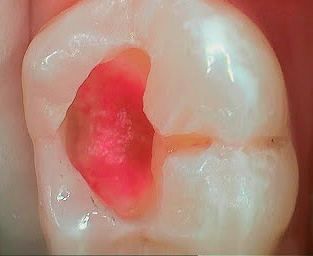
On a note
Sometimes caries marker is used for the differential diagnosis of caries.For example, areas of enamel stained by fluorosis or hypoplasia marker does not stain.
The caries indicator has proven itself very well in order to train young doctors and students, as well as to demonstrate the affected areas to the patient himself. Often, it is also used to control the state of enamel areas near crowns and fillings (it helps in violation of the regional fit of seals, cracks, incorrect setting), in fissures, where it is very difficult to notice the developing caries in the early stages.
The use of markers somewhat reduces the speed of treatment of the tooth, but it eliminates the element of doubt when cleaning the affected dentin, thus making the therapy better and more reliable.
Classification of caries detectors and their components
Today in the world of dental practice are actively used several types of caries detectors:
- Chemical detectors are precisely those markers whose principle of action is based on the interaction of a brightly colored substance with a surface affected by a carious process.
- Optical detectors in which a beam of light with a wavelength of 405 nm is used to detect pathological changes in a tooth.According to the degree of its refraction at each tooth segment, a special analyzing program displays different colors on the computer screen, thus forming a visual multi-colored image of the tooth, on which, in the presence of caries, damaged areas are clearly visible.
- Laser detectors, the principle of action of which is similar to the optical one, but a laser beam works as a sensitive element in them.

Optical and laser detectors are very convenient in the diagnosis of caries, but with their help it is more difficult to control the quality and completeness of cleaning the damaged areas of the tooth. In addition, they are expensive to acquire and today are the property of only elite clinics.
Caries-markers are much more accessible than laser and optical devices, and therefore they are used in most clinics, including those in fairly low cost. Their use does not lead to an increase in the cost of caries treatment, while significantly facilitating the work of a doctor.
Of the active substances in caries markers, acid fuchsin is a commonly used synthetic synthetic dye.in aqueous solutions having intense red color. The photo shows how well the carious parts of the tooth are stained:
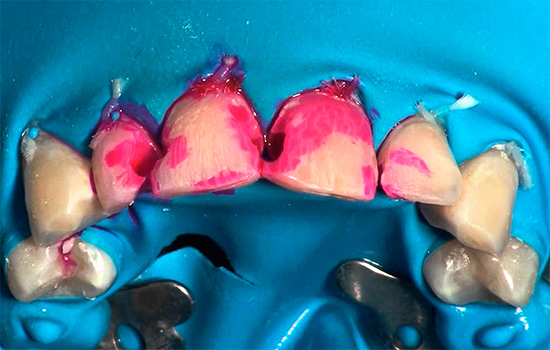
Methylene blue is used less often to detect caries, which works similarly to fuchsin, but colors the affected areas blue.
Instructions for the use of markers
Instructions for use of caries-marker is simple. To diagnose caries with the help of markers (for example, in the white spot stage), the teeth are washed with water, dried, and the preparation is applied to the enamel surface. You can squeeze the marker directly from the syringe, but you can also use special foam balls for this.
The drug is left on the enamel for 5-10 seconds, after which the tooth is washed with water. Caries-affected areas remain colored with the indicator.
The drier the tooth surface before the marker is applied to it and the higher the microporosity of its tissues, the more intense will be the color of the painted surfaces.
During treatment with a drill, all tissues painted in the color of the indicator are removed with boron. After this, the cavity walls are again treated with a marker for 5-10 seconds and rinsed again with water.When new colored areas appear, they are removed again. The procedure is repeated until, when processing all the walls of the cavity, staining with a marker stops.
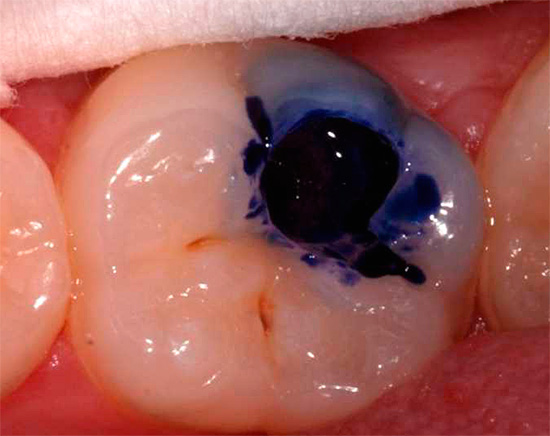
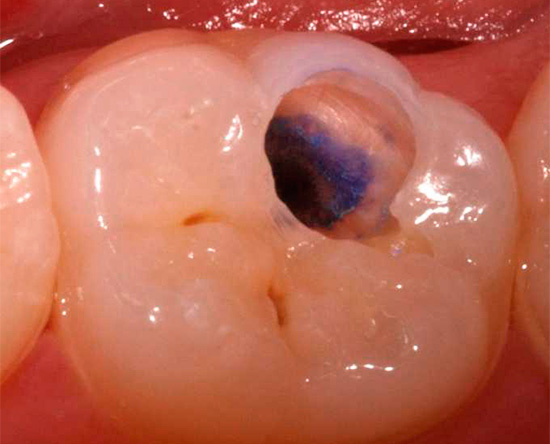
Such instructions are universal for all standard caries-indicators, including methylene blue.
Important:
Caries-marker stains not only carious surfaces, but also plaque on the teeth and tartar. Therefore, it is important not to confuse them with areas of carious lesions.
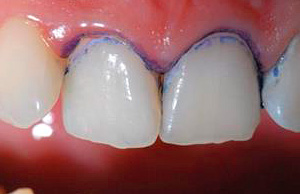
Caries markers are not intended for home use. These are exclusively professional tools that only a doctor uses, and more than half of the cases of using such tools are not related to the diagnosis of caries, but using them to improve the efficiency of cleaning carious cavities during therapy.
Staining with a marker especially helps in removing necrotic, infected dentin, which often leads to complications of caries. It is the remnants of necrotic dentin that are not mistakenly removed by a doctor that can lead to the development of caries under crowns and fillings (secondary caries). With a clear following of the instructions, the caries marker allows you to completely clean the cavity from infected tissue.
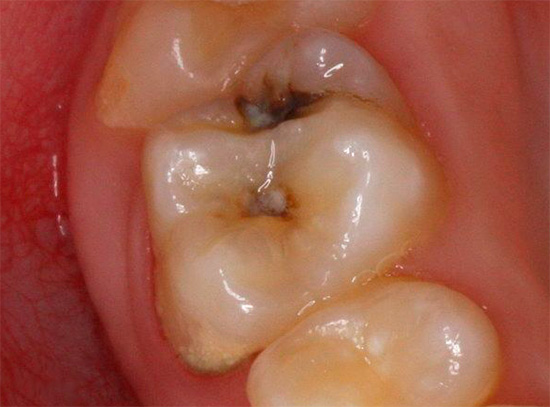
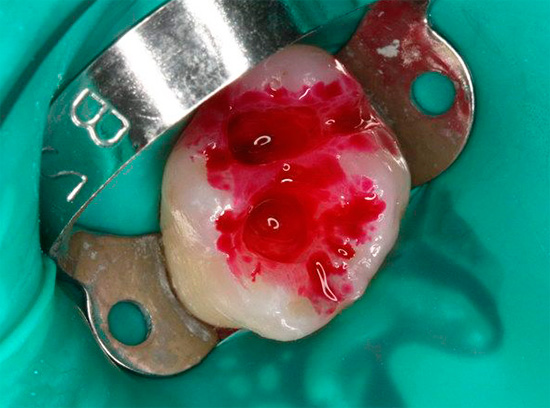
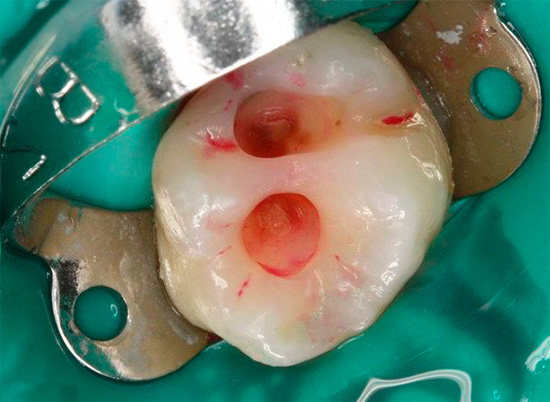
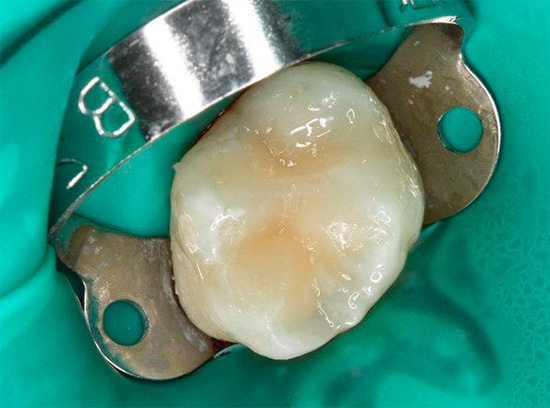
On a note
Caries-markers are used at the dental reception, where there is no hard time limit, as in most public institutions. To use these tools as an additional diagnostic method, it is required that the treatment be carried out for at least 30-60 minutes. Saving time at this stage, especially with deep caries, can lead to severe pulp lesions (“nerve”).
The point is that only complete excision of the diseased, non-viable carious dentin can reduce the risks of "postoperative sensitivity", recurrent caries and infectious inflammation of the pulp. A caries marker (detector), when all the diagnostic conditions are fulfilled, is recommended to practicing dentists to guarantee the quality of the treatment performed.
Warnings and safety precautions
The main danger that should be avoided when working with a caries marker is the possibility of staining with a healthy indicator, not damaged dentine caries. This situation occurs when the marker is too long on the tooth for more than 10 seconds.Therefore, the optimal processing time of the tooth is about 7 seconds.
For this reason, it is not recommended to process many teeth at once. This reduces the efficiency of the work, and by the time the first teeth are already washed, the remaining marker can already begin to stain healthy tissue.
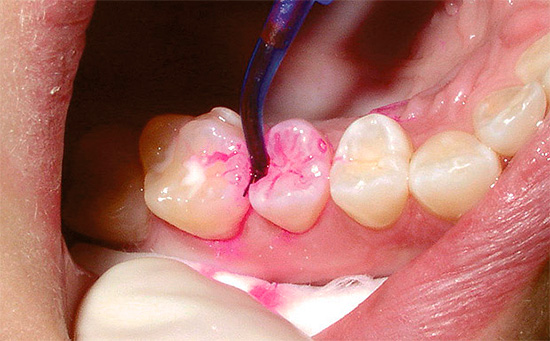
Also, with a significant deepening inside the tooth, it is necessary to correctly distinguish the areas painted with red indicators from the pink color of dentin near the pulp.
Caries markers are harmless to human health. However, some of them contain propylene glycol and can cause allergies in particularly sensitive patients if they come into contact with mucous membranes. Unpleasant symptoms quickly pass after washing the mucous membranes with water.
On a note
Due to the rich color of caries markers are able to leave persistent marks on clothes and skin surface. They can be washed off with a cotton wool moistened with vinegar, but this should be done immediately after the marker gets on the skin or fabric, since later the stain will be harder to remove.
Prices for caries markers from different manufacturers
The most famous and often used in clinics are caries markers of the following manufacturers:
- Voco, a German-made drug. The price of 1 g of caries marker Voco is about 400 rubles, and 3 grams - about 1000 rubles.
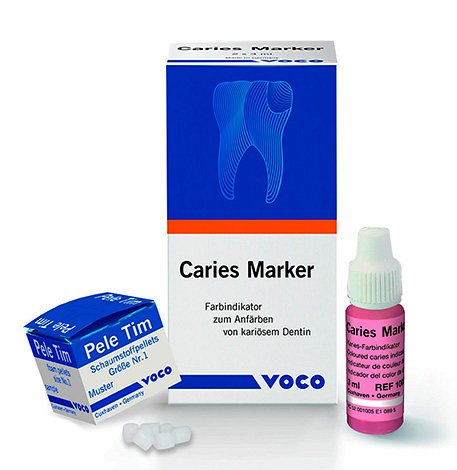
- Kuraray, a Japanese remedy - the price of this caries indicator is about 2500 rubles for 6 ml.

- Color test of the Russian company "VladMiVa". Perhaps this is the most affordable drug: a bottle of 20 ml costs about 100 rubles.
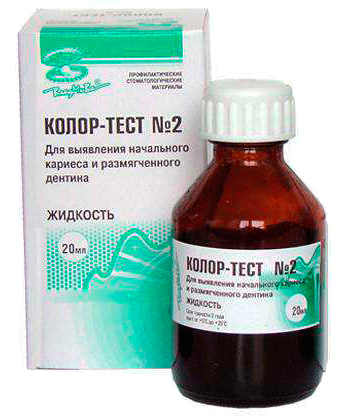
These prices vary greatly, depending on the city, as well as the clinic, which includes them in the calculation of the cost of treatment. However, the difference between the cost of different drugs given figures reflect correctly.
At the same time there is no fundamental difference in the work and application of different markers. Typically, the dentist tries to work with several of them, and eventually stops at the drug, the work with which it is most convenient.
Interesting video: an example of the use of caries-marker in practice
Use of a caries detector during tooth preparation

